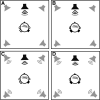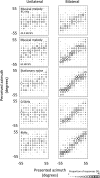Differing Bilateral Benefits for Spatial Release From Masking and Sound Localization Accuracy Using Bone Conduction Devices
- PMID: 35588503
- PMCID: PMC9592172
- DOI: 10.1097/AUD.0000000000001234
Differing Bilateral Benefits for Spatial Release From Masking and Sound Localization Accuracy Using Bone Conduction Devices
Abstract
Objectives: Normal binaural hearing facilitates spatial hearing and therefore many everyday listening tasks, such as understanding speech against a backdrop of competing sounds originating from various locations, and localization of sounds. For stimulation with bone conduction hearing devices (BCD), used to alleviate conductive hearing losses, limited transcranial attenuation results in cross-stimulation so that both cochleae are stimulated from the position of the bone conduction transducer. As such, interaural time and level differences, hallmarks of binaural hearing, are unpredictable at the level of the inner ears. The aim of this study was to compare spatial hearing by unilateral and bilateral BCD stimulation in normal-hearing listeners with simulated bilateral conductive hearing loss.
Design: Bilateral conductive hearing loss was reversibly induced in 25 subjects (mean age = 28.5 years) with air conduction and bone conduction (BC) pure-tone averages across 0.5, 1, 2, and 4 kHz (PTA 4 ) <5 dB HL. The mean (SD) PTA 4 for the simulated conductive hearing loss was 48.2 dB (3.8 dB). Subjects participated in a speech-in-speech task and a horizontal sound localization task in a within-subject repeated measures design (unilateral and bilateral bone conduction stimulation) using Baha 5 clinical sound processors on a softband. For the speech-in-speech task, the main outcome measure was the threshold for 40% correct speech recognition when masking speech and target speech were both colocated (0°) and spatially and symmetrically separated (target 0°, maskers ±30° and ±150°). Spatial release from masking was quantified as the difference between colocated and separated masking and target speech thresholds. For the localization task, the main outcome measure was the overall variance in localization accuracy quantified as an error index (0.0 = perfect performance; 1.0 = random performance). Four stimuli providing various spatial cues were used in the sound localization task.
Results: The bilateral BCD benefit for recognition thresholds of speech in competing speech was statistically significant but small regardless if the masking speech signals were colocated with, or spatially and symmetrically separated from, the target speech. Spatial release from masking was identical for unilateral and bilateral conditions, and significantly different from zero. A distinct bilateral BCD sound localization benefit existed but varied in magnitude across stimuli. The smallest benefit occurred for a low-frequency stimulus (octave-filtered noise, CF = 0.5 kHz), and the largest benefit occurred for unmodulated broadband and narrowband (octave-filtered noise, CF = 4.0 kHz) stimuli. Sound localization by unilateral BCD was poor across stimuli.
Conclusions: Results suggest that the well-known transcranial transmission of BC sound affects bilateral BCD benefits for spatial processing of sound in differing ways. Results further suggest that patients with bilateral conductive hearing loss and BC thresholds within the normal range may benefit from a bilateral fitting of BCD, particularly for horizontal localization of sounds.
Copyright © 2022 The Authors. Ear & Hearing is published on behalf of the American Auditory Society, by Wolters Kluwer Health, Inc.
Conflict of interest statement
The authors have no conflicts of interest to disclose.
Figures








Similar articles
-
Effects of Simulated and Profound Unilateral Sensorineural Hearing Loss on Recognition of Speech in Competing Speech.Ear Hear. 2020 Mar/Apr;41(2):411-419. doi: 10.1097/AUD.0000000000000764. Ear Hear. 2020. PMID: 31356386
-
Unilateral and Bilateral Audiological Benefit With an Adhesively Attached, Noninvasive Bone Conduction Hearing System.Otol Neurotol. 2018 Sep;39(8):1025-1030. doi: 10.1097/MAO.0000000000001924. Otol Neurotol. 2018. PMID: 30015748
-
Audiometric evaluation of bilaterally fitted bone-anchored hearing aids.Audiology. 2001 May-Jun;40(3):158-67. Audiology. 2001. PMID: 11465298
-
Implantable Devices for Single-Sided Deafness and Conductive or Mixed Hearing Loss: A Health Technology Assessment.Ont Health Technol Assess Ser. 2020 Mar 6;20(1):1-165. eCollection 2020. Ont Health Technol Assess Ser. 2020. PMID: 32194878 Free PMC article.
-
A Systematic Review of Surgical Characteristics and Adverse Events of an Active, Transcutaneous Bone Conduction Device.Ann Otol Rhinol Laryngol. 2024 Nov;133(11):956-966. doi: 10.1177/00034894241283269. Epub 2024 Sep 22. Ann Otol Rhinol Laryngol. 2024. PMID: 39307966
Cited by
-
Teenagers and Young Adults with Cochlear Implants: A Multidisciplinary Follow-Up Study Approach and Baseline Characteristics.Audiol Res. 2025 Feb 12;15(1):16. doi: 10.3390/audiolres15010016. Audiol Res. 2025. PMID: 39997160 Free PMC article.
-
Spatial Release From Masking With Bilateral Bone Conduction Stimulation at Mastoid for Normal Hearing Subjects.Trends Hear. 2024 Jan-Dec;28:23312165241234202. doi: 10.1177/23312165241234202. Trends Hear. 2024. PMID: 38549451 Free PMC article.
-
A pilot study on spatial hearing in children with congenital unilateral aural atresia.Front Pediatr. 2023 Aug 9;11:1194966. doi: 10.3389/fped.2023.1194966. eCollection 2023. Front Pediatr. 2023. PMID: 37622080 Free PMC article.
-
The Merits of Bilateral Application of Middle Ear Implants in Patients With Bilateral Conductive and/or Mixed Hearing Loss.Trends Hear. 2024 Jan-Dec;28:23312165241264466. doi: 10.1177/23312165241264466. Trends Hear. 2024. PMID: 39106413 Free PMC article.
References
-
- Asp F., & Reinfeldt S. (2018). Horizontal sound localisation accuracy in individuals with conductive hearing loss: Effect of the bone conduction implant. Int J Audiol, 57, 657–664. - PubMed
-
- Asp F., & Reinfeldt S. (2019). Effects of simulated and profound unilateral sensorineural hearing loss on recognition of speech in competing speech. Ear Hear. - PubMed
-
- Asp F., & Reinfeldt S. (2020). Effects of simulated and profound unilateral sensorineural hearing loss on recognition of speech in competing speech. Ear Hear, 41, 411–419. - PubMed
-
- Asp F., Eskilsson G., Berninger E. (2011). Horizontal sound localization in children with bilateral cochlear implants: Effects of auditory experience and age at implantation. Otol Neurotol, 32, 558–564. - PubMed
-
- Asp F., Olofsson Å., Berninger E. (2016). Corneal-reflection eye-tracking technique for the assessment of horizontal sound localization accuracy from 6 months of age. Ear Hear, 37, e104–e118. - PubMed
MeSH terms
LinkOut - more resources
Full Text Sources
Medical
Research Materials
Miscellaneous

